Citizen Sensors for SHM: Towards a Crowdsourcing Platform
Abstract
:1. Introduction
2. Multilayered Computer Platform
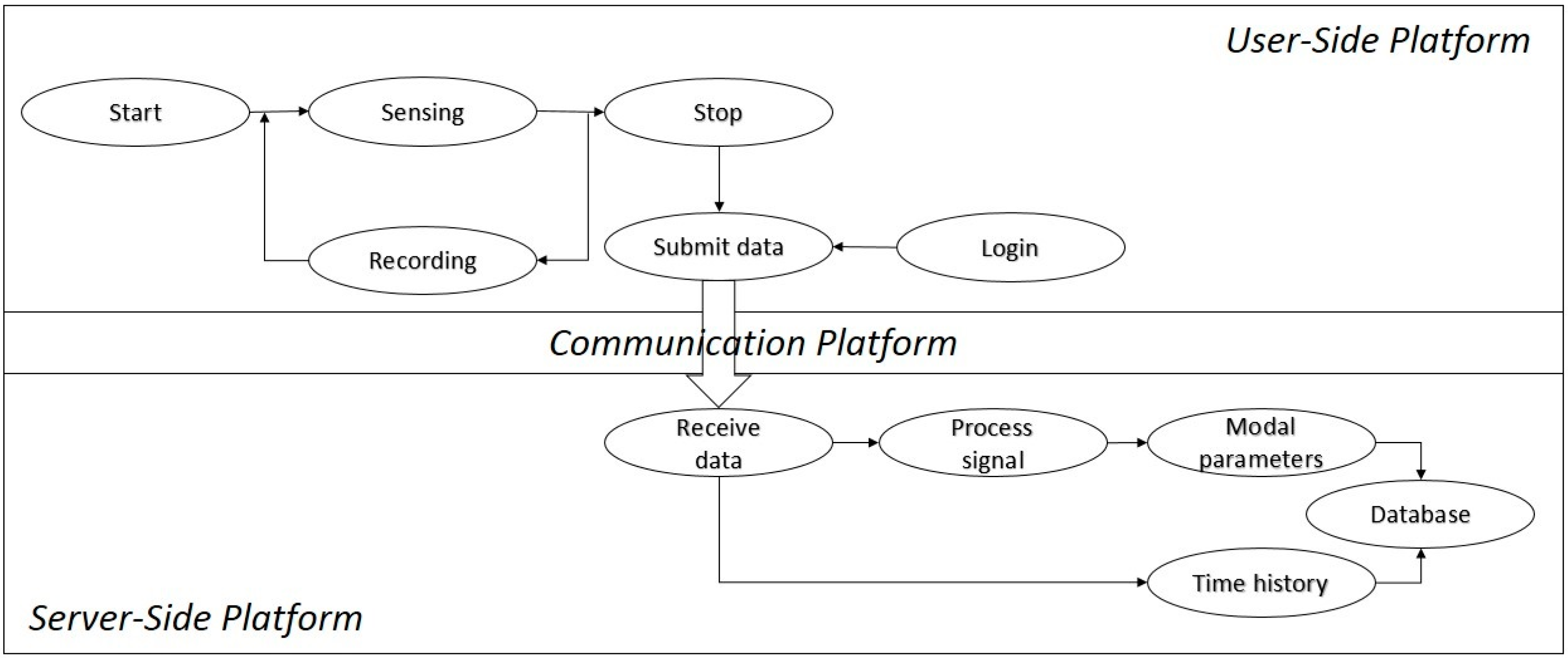
2.1. User-Side Sensing and Acquisition
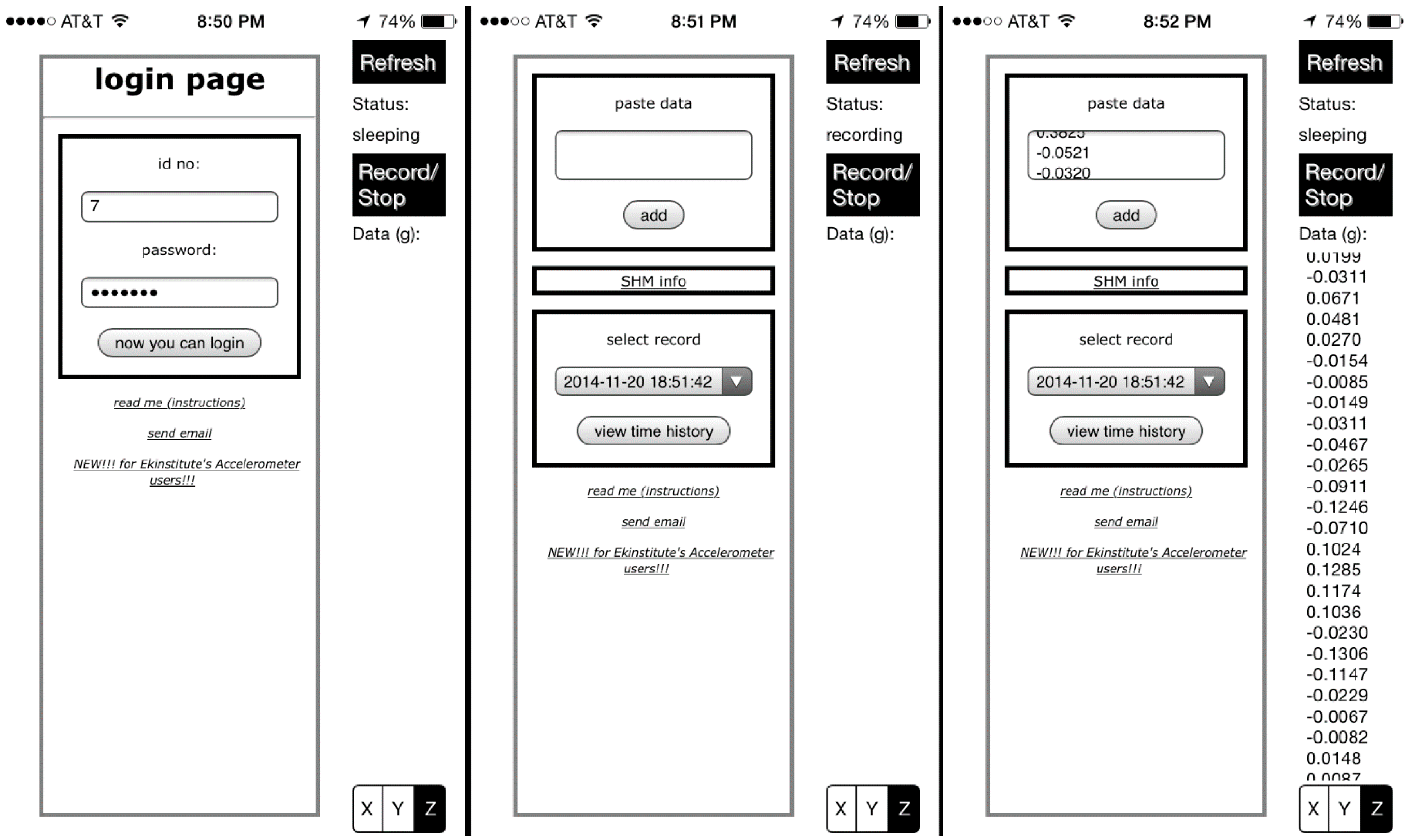
2.2. Server-Side Processing and Database


3. Crowdsourcing
“Crowdsourcing is a type of participative online activity in which an individual, an institution, or company proposes to a group of individuals of varying knowledge, homogeneity and number, via a flexible open call, the voluntary undertaking of a task. The undertaking of the task, of variable complexity and modularity, and in which the crowd should participate bringing their work, money, knowledge and/or experience, always entails mutual benefit. The user will receive the satisfaction of a given type of need, be it economic, social recognition, self-esteem, or the development of individual skills, while the crowdsourcer will obtain and utilize to their advantage what the user has brought to the venture, whose form will depend on the type of activity undertaken.”
3.1. Sensors
3.2. Data Wisdom, Contribution Quality, and Web-Extension
3.3. Human Skill and Incentives
3.4. Involvement
| Application | Web | Involvement | Data | Contribution | Incentives | Skill | Sensors | Location |
|---|---|---|---|---|---|---|---|---|
| Gigwalk.com | Yes | Participatory | Individual | Heterogeneous | Monetary | Labor | Camera | Yes |
| CityExplorer | No | Participatory | Collective | Homogeneous | Entertainment | Visual | Camera | Yes |
| PotHole | No | Opportunistic | Collective | Homogeneous | Ethical | Non | Vibration | Yes |
| CS4SHM | Yes | Both | Both | Both | Multiple | Multiple | Multiple | Yes |
4. Case Study: Monitoring of a Pedestrian Link Bridge
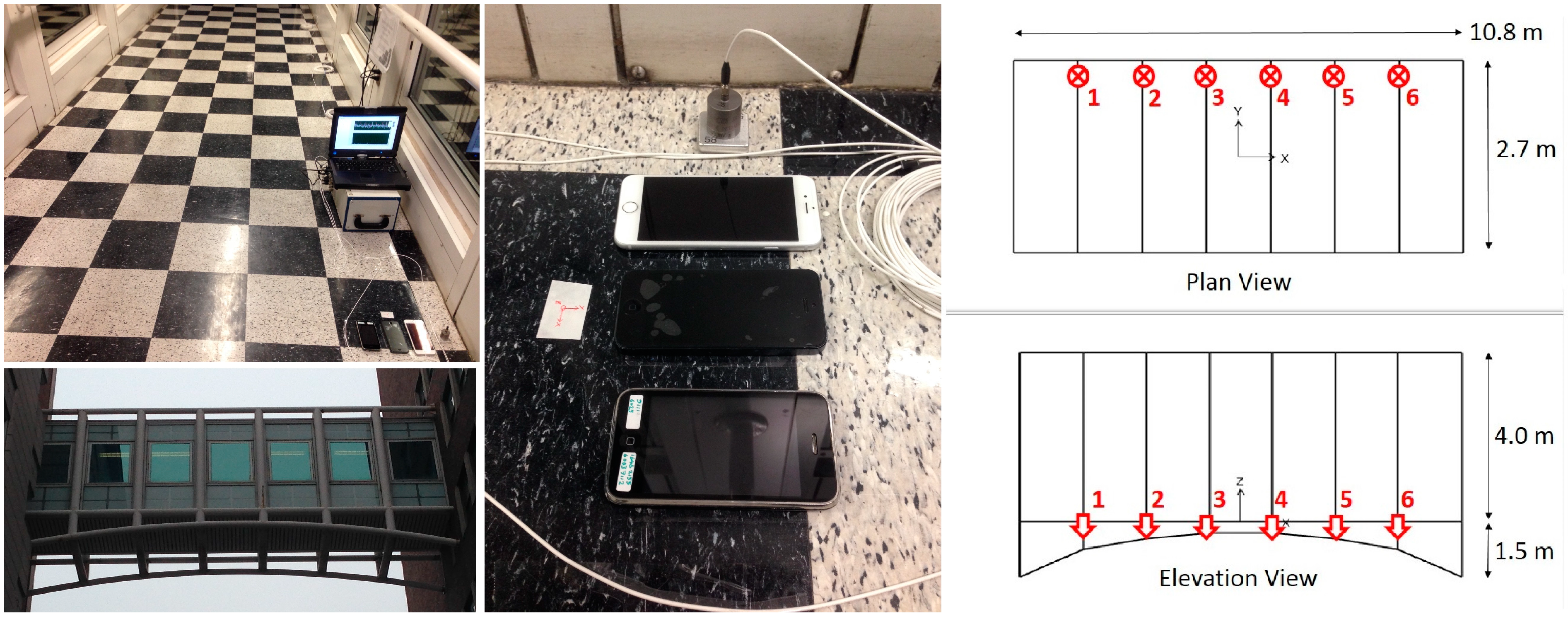
4.1. Measurement, Data Processing and Modal Identification
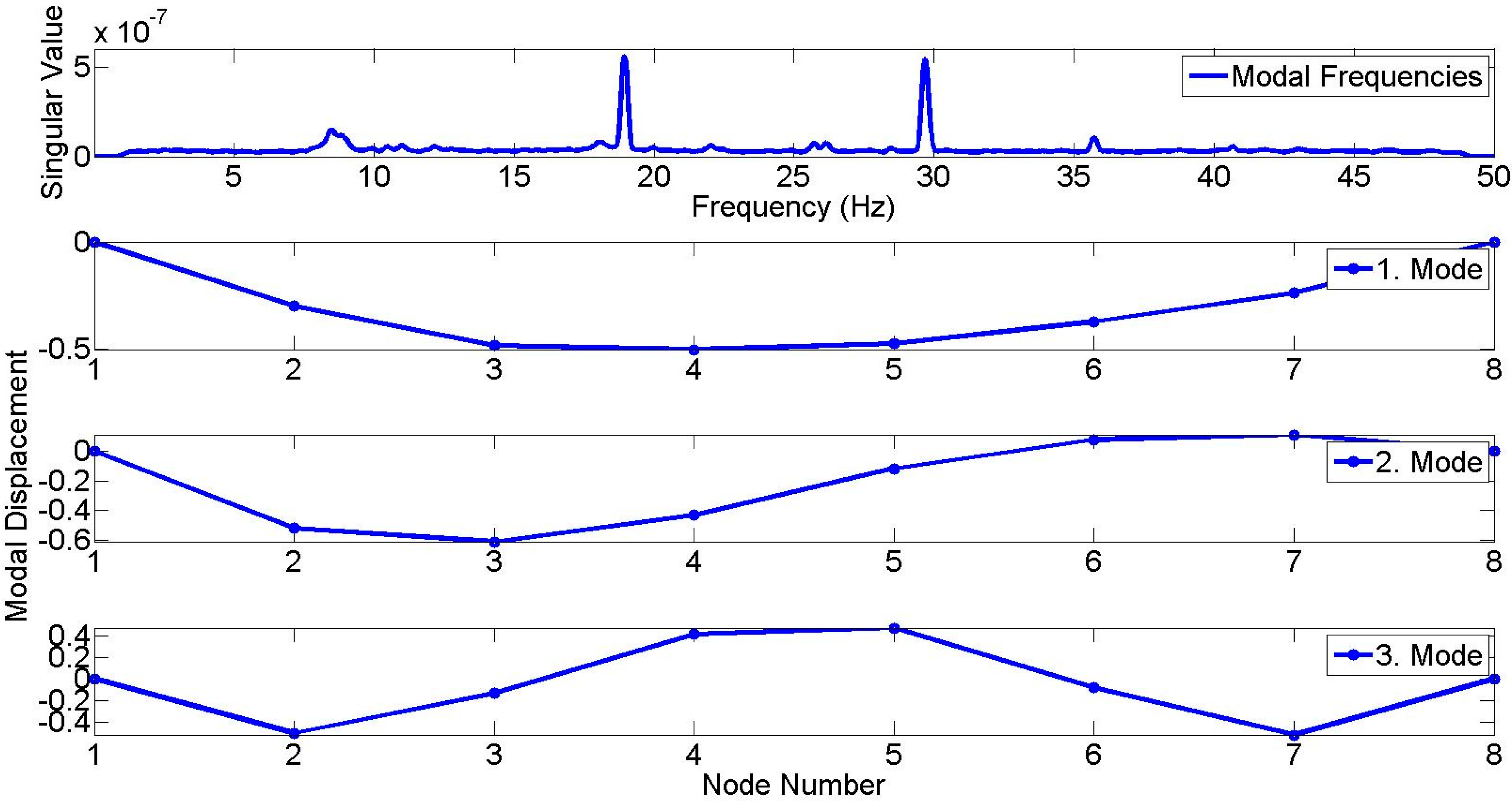
4.2. Uncertainties Associated with Citizen Participation
- (1)
- Smartphone location and orientation might change according to smartphone users’ initiative.
- (2)
- Smartphone coupling conditions might vary according to external accessories or surrounding material.
- (3)
- Measurement duration can extensively vary according to the users’ motivation.
- (4)
- Users should not be subjected to additional charges for data submission and therefore are allowed to prefer different communication platforms to submit data (wireless, cellular, etc.).
| Test No | Time (min) | Sensor Location | Coupling Conditions |
|---|---|---|---|
| 1 | 40 | Mid-span | Adhesive Taped |
| 2 | 40 | Mid-span | Free to Move–With Case |
| 3 | 40 | Mid-span | Free to Move–No Case |
| 4 | 40 | Mid-span | Free to Move–In Bag |
| 5 | 40 | One-third Span | Free to Move–No Case |
| 6 | 40 | One-sixth Span | Free to Move–No Case |

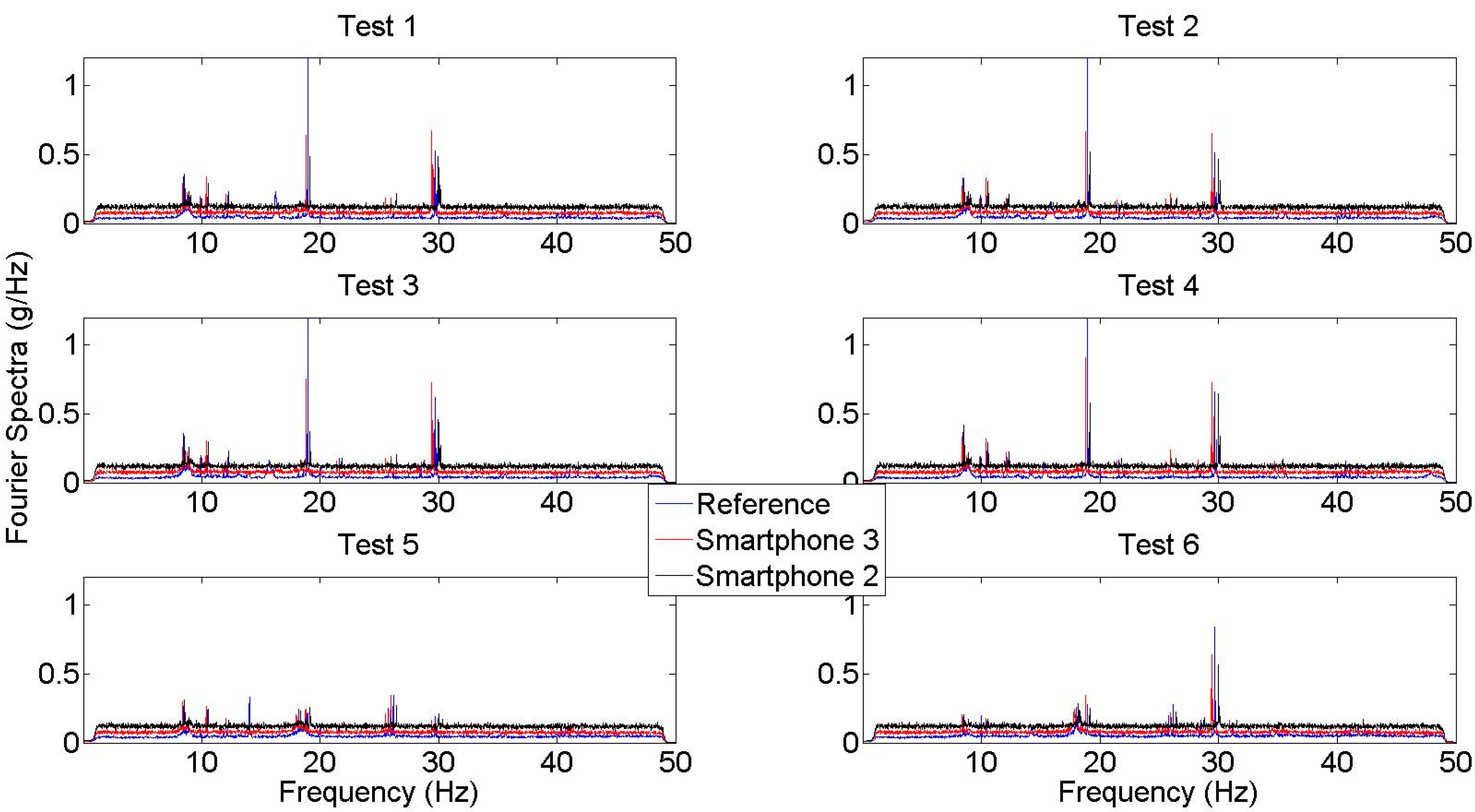
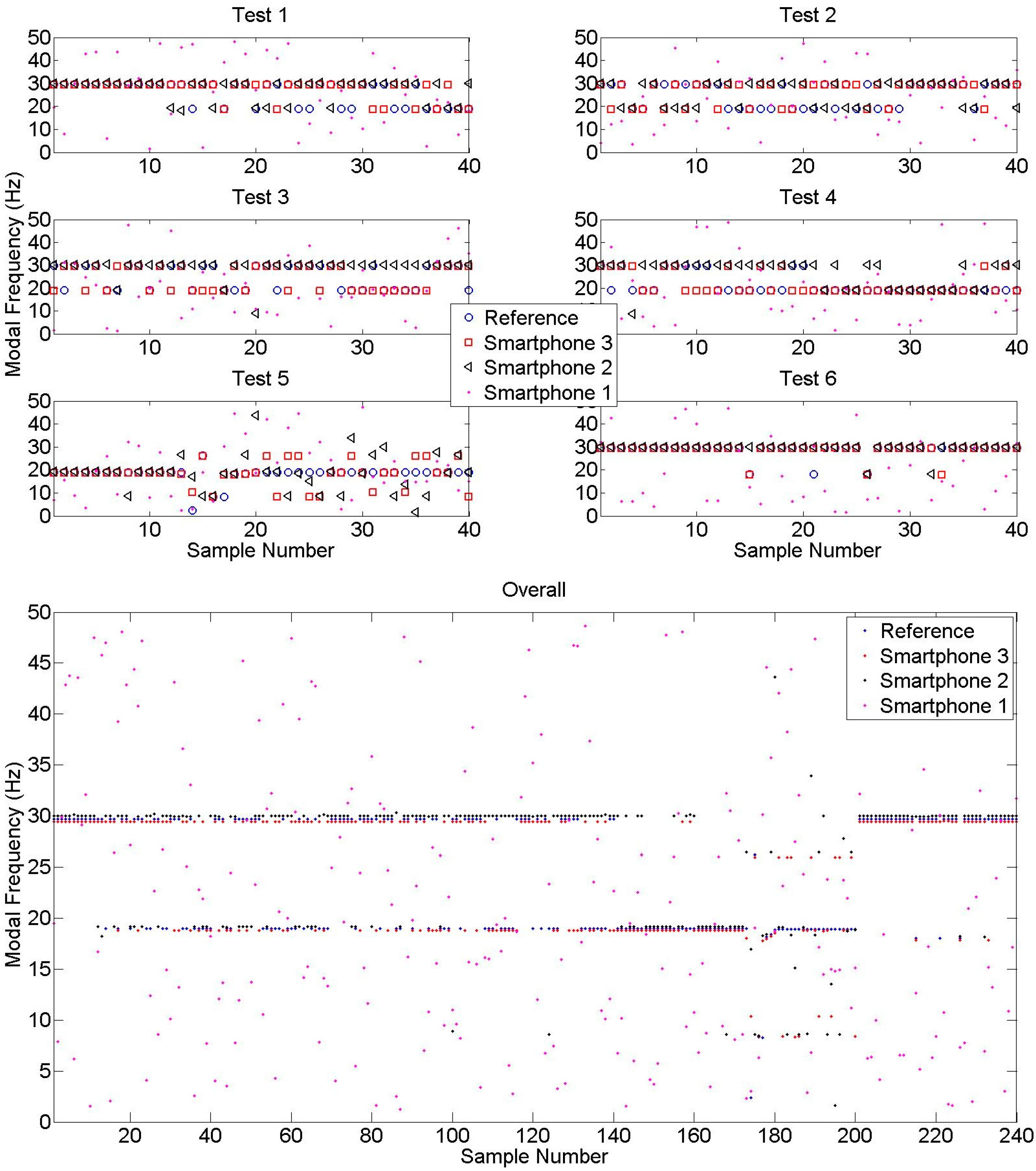
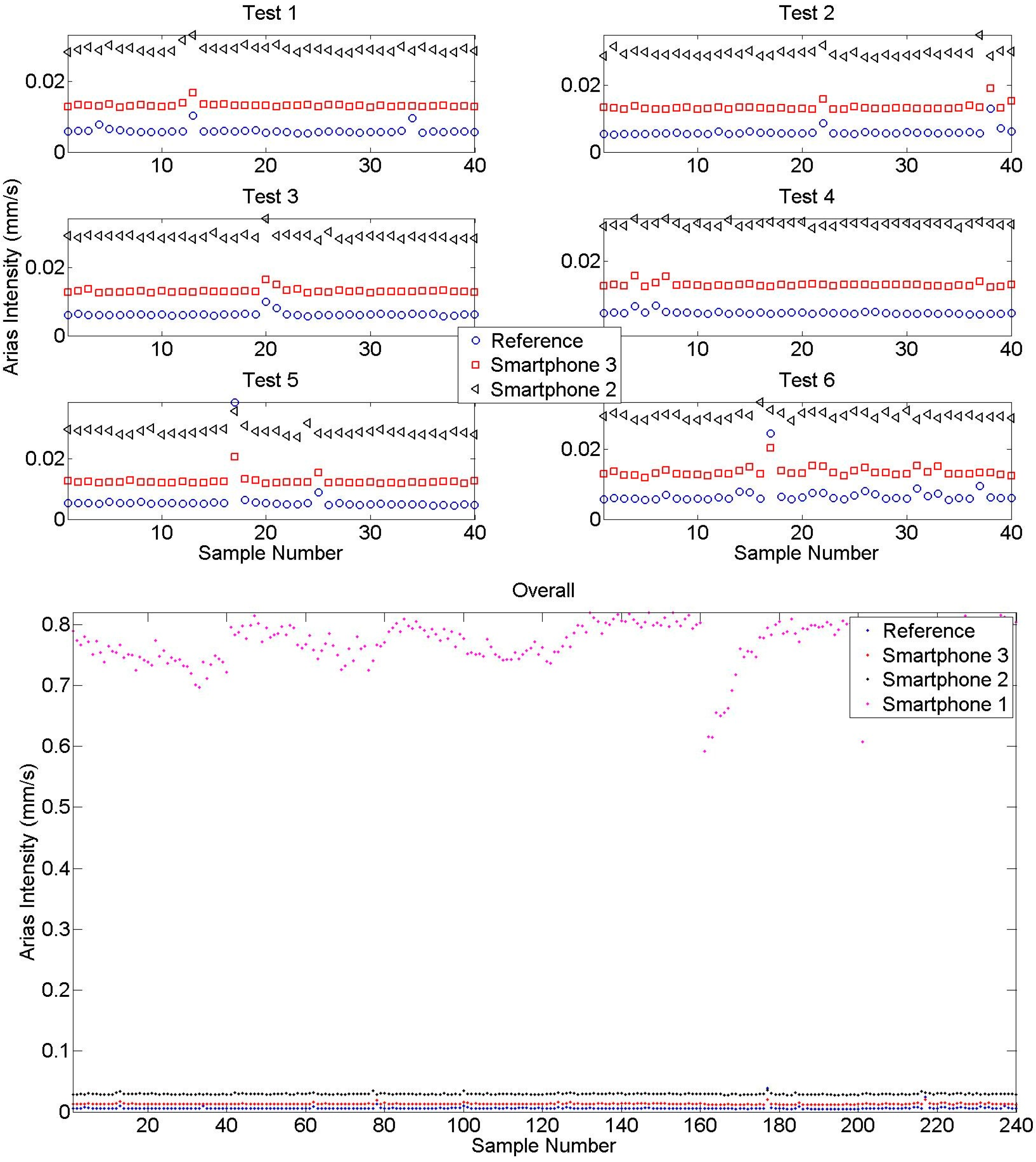
| Sensor | f1averaged | Error (%) | f2averaged | Error (%) | f3averaged | Error (%) |
|---|---|---|---|---|---|---|
| Reference | 8.48 | 0.24 | 18.97 | 0.11 | 29.68 | 0.04 |
| Smartphone 3 | 8.40 | 0.71 | 18.80 | 0.79 | 29.43 | 0.81 |
| Smartphone 2 | 8.57 | 1.30 | 19.15 | 1.06 | 29.98 | 1.05 |
| Smartphone 1 | - | - | - | - | - | - |
| Test No | Sensor | PVAμ (g) | PVAσ (g) | AIμ (mm/s) | AIσ (mm/s) |
|---|---|---|---|---|---|
| 1 | Reference | 0.0041 | 0.0030 | 0.0061 | 0.0010 |
| Smartphone 3 | 0.0044 | 0.0004 | 0.0133 | 0.0007 | |
| Smartphone 2 | 0.0064 | 0.0005 | 0.0293 | 0.0010 | |
| Smartphone 1 | 0.0278 | 0.0017 | 0.7455 | 0.0202 | |
| 2 | Reference | 0.0036 | 0.0032 | 0.0060 | 0.0013 |
| Smartphone 3 | 0.0046 | 0.0010 | 0.0134 | 0.0011 | |
| Smartphone 2 | 0.0067 | 0.0006 | 0.0297 | 0.0012 | |
| Smartphone 1 | 0.0286 | 0.0022 | 0.7718 | 0.0218 | |
| 3 | Reference | 0.0031 | 0.0008 | 0.0063 | 0.0007 |
| Smartphone 3 | 0.0044 | 0.0007 | 0.0131 | 0.0007 | |
| Smartphone 2 | 0.0065 | 0.0006 | 0.0292 | 0.0010 | |
| Smartphone 1 | 0.0289 | 0.0022 | 0.7710 | 0.0206 | |
| 4 | Reference | 0.0031 | 0.0009 | 0.0061 | 0.0005 |
| Smartphone 3 | 0.0045 | 0.0006 | 0.0136 | 0.0006 | |
| Smartphone 2 | 0.0068 | 0.0007 | 0.0299 | 0.0006 | |
| Smartphone 1 | 0.0297 | 0.0020 | 0.7952 | 0.0210 | |
| 5 | Reference | 0.0042 | 0.0048 | 0.0061 | 0.0053 |
| Smartphone 3 | 0.0044 | 0.0013 | 0.0125 | 0.0014 | |
| Smartphone 2 | 0.0067 | 0.0009 | 0.0290 | 0.0014 | |
| Smartphone 1 | 0.0308 | 0.0032 | 0.7560 | 0.0622 | |
| 6 | Reference | 0.0049 | 0.0046 | 0.0069 | 0.0030 |
| Smartphone 3 | 0.0047 | 0.0007 | 0.0136 | 0.0014 | |
| Smartphone 2 | 0.0065 | 0.0005 | 0.0296 | 0.0010 | |
| Smartphone 1 | 0.0307 | 0.0023 | 0.7737 | 0.0487 |


5. Conclusions
- (1)
- The developed platform is novel in the way it utilizes ubiquitous smartphones, crowdsourcing and citizen engagement as means of vibration-based SHM. It lays a foundation for a future citizen-centered cyber-physical sensor system for monitoring the integrity and safety of spatially-distributed urban infrastructure.
- (2)
- Crowdsourcing-based SHM is a unique participatory sensing example in the way it synthesizes distinctive crowdsourcing parameters such as participatory and opportunistic involvement, multiple incentives, individual and collective data wisdom, and heterogeneous and homogeneous contribution with a hybrid human-sensor framework.
- (3)
- Considering different generations of smartphone models, new generation smartphones provide better performance for vibration measurement. Time history data, Fourier spectra, and Arias intensity results show that as the phone generation gets younger, accuracy and sensitivity gets closer to the high quality reference measurements. In contrast, the oldest generation, Smartphone 1, is subjected to a high noise level which can mask structure’s dynamic characteristics in vibration signals. Although amplitude performance changes significantly according to the smartphone generation, modal identification results obtained from new generation smartphones have extremely small errors ranging around 1%, whereas the oldest generation, Smartphone 1, is incapable of identifying modal frequencies.
- (4)
- The results show that the presented phone-structure coupling conditions did not affect monitoring performance significantly. On the other hand, such observation is likely to change as the vibration level gets higher than ambient vibration. Therefore, coupling effects under operational or extreme environmental vibrations can be different, and should be investigated in the future.
- (5)
- Sensor location has an important effect on identification results, since modal displacements vary according to the measurement location. For instance, data submissions from one-sixth span identify the 3rd mode frequently, whereas the 2nd mode is dominant for other submission locations.
- (6)
- Collecting a large number of small-sized vibration data submissions and averaging their frequency spectra can generate a useful database for crowdsourcing-based modal identification and monitoring purposes. This will enables the setup of a reliable large-sized database by small contributions from each citizen. In other words, retrieval of ubiquitous vibration data from smartphones enables identification of modal frequencies accurately without excessive citizen effort.
- (7)
- The web platform provides secure but online, automated, remote, and widely accessible media for vibration data and modal identification results. What is more, the mobile platform provides users with the opportunity to choose the preferred communication tools, which means users can submit the data either instantaneously or when preferred communication tools are available.
- (8)
- The proposed methodology is cost-effective and sustainable since the sensor instrumentation and maintenance is provided spontaneously by smartphone users. If the crowdsourcing model is improved, and the mobile application is distributed among the community, it can become an innovative source for long-term SHM applications.
Author Contributions
Conflicts of Interest
References
- Skolnik, D.; Lei, Y.; Yu, E.; Wallace, J.W. Identification, model updating, and response prediction of an instrumented 15-story steel-frame building. Earthq. Spectra 2006, 22, 781–802. [Google Scholar]
- Catbas, F.N.; Susoy, M.; Frangopol, D.M. Structural health monitoring and reliability estimation: Long span truss bridge application with environmental monitoring data. Eng. Struct. 2008, 30, 2347–2359. [Google Scholar]
- Moaveni, B.; He, X.; Conte, J.P.; Restrepo, J.I. Damage identification study of a seven-story full-scale building slice tested on the UCSD-NEES shake table. Struct. Saf. 2010, 32, 347–356. [Google Scholar]
- Gomez, H.C.; Fanning, P.J.; Feng, M.Q.; Lee, S. Testing and long-term monitoring of a curved concrete box girder bridge. Eng. Struct. 2011, 33, 2861–2869. [Google Scholar]
- Ozer, E.; Soyoz, S. Vibration-based damage detection and seismic performance assessment of bridges. Earthq. Spectra 2015, 31, 137–157. [Google Scholar]
- Ozer, E.; Feng, M.Q.; Soyoz, S. SHM-integrated bridge reliability estimation using multivariate stochastic processes. Earthq. Eng. Struct. Dyn. 2015, 44, 601–618. [Google Scholar]
- Carden, E.P.; Fanning, P. Vibration based condition monitoring: A review. Struct. Health Monit. 2004, 3, 355–377. [Google Scholar]
- Wald, D.J.; Quitoriano, V.; Worden, C.B.; Hopper, M.; Dewey, J.W. USGS “Did you feel it?” internet-based macroseismic intensity maps. Ann. Geophys. 2012, 54, 688–707. [Google Scholar]
- Cochran, E.; Lawrence, J.; Christensen, C.; Chung, A. A novel strong-motion seismic network for community participation in earthquake monitoring. IEEE Instrum. Measur. Mag. 2009, 12, 8–15. [Google Scholar]
- Clayton, R.W.; Heaton, T.; Chandy, M.; Krause, A.; Kohler, M.; Bunn, J.; Aivazis, M. Community seismic network. Ann. Geophys. 2012, 54, 738–747. [Google Scholar]
- Dashti, S.; Bray, J.D.; Reilly, J.; Glaser, S.; Bayen, A.; Mari, E. Evaluating the Reliability of Phones as Seismic Monitoring Instruments. Earthq. Spectra 2014, 30, 721–742. [Google Scholar]
- Morgenthal, G.; Höpfner, H. The application of smartphones to measuring transient structural displacements. J. Civil Struct. Health Monit. 2012, 2, 149–161. [Google Scholar]
- Höpfner, H.; Morgenthal, G.; Schirmer, M.; Naujoks, M.; Halang, C. On measuring mechanical oscillations using smartphone sensors: Possibilities and limitation. ACM SIGMOBILE Mob. Comput. Commun. Rev. 2013, 17, 29–41. [Google Scholar]
- Kohler, M.D.; Heaton, T.H.; Cheng, M.H. The Community Seismic Network and Quake-Catcher Network: Enabling structural health monitoring through instrumentation by community participants. Proc. SPIE 2013, 8692. [Google Scholar] [CrossRef]
- Howe, J. The rise of crowdsourcing. Wired Mag. 2006, 14, 1–4. [Google Scholar]
- Brabham, D.C. Crowdsourcing as a model for problem solving an introduction and cases. Convergence 2008, 14, 75–90. [Google Scholar]
- Albors, J.; Ramos, J.C.; Hervas, J.L. New learning network paradigms: Communities of objectives, crowdsourcing, wikis and open source. Int. J. Inf. Manag. 2008, 28, 194–202. [Google Scholar]
- Hammon, D.K.L.; Hippner, H. Crowdsourcing. Bus. Inf. Syst. Eng. 2012, 4, 163–166. [Google Scholar]
- Zhao, Y.; Zhu, Q. Evaluation on crowdsourcing research: Current status and future direction. Inf. Syst. Front. 2014, 16, 417–434. [Google Scholar]
- Schenk, E.; Guittard, C. Towards a characterization of crowdsourcing practices. J. Innov. Econ. Manag. 2011, 7, 93–107. [Google Scholar]
- Estellés-Arolas, E.; González-Ladrón-de-Guevara, F. Towards an integrated crowdsourcing definition. J. Inf. Sci. 2012, 38, 189–200. [Google Scholar]
- Von Hippel, E. The dominant role of users in the scientific instrument innovation process. Res. Policy 1976, 5, 212–239. [Google Scholar]
- Corney, J.R.; Torres-Sánchez, C.; Jagadeesan, A.P.; Yan, X.T.; Regli, W.C.; Medellin, H. Putting the crowd to work in a knowledge-based factory. Adv. Eng. Inform. 2010, 24, 243–250. [Google Scholar]
- Rossen, B.; Lok, B. A crowdsourcing method to develop virtual human conversational agents. Int. J. Hum.-Comput. Stud. 2012, 70, 301–319. [Google Scholar]
- Kazman, R.; Chen, H.M. The metropolis model a new logic for development of crowdsourced systems. Commun. ACM 2009, 52, 76–84. [Google Scholar]
- Doan, A.; Ramakrishnan, R.; Halevy, A.Y. Crowdsourcing systems on the world-wide web. Commun. ACM 2011, 54, 86–96. [Google Scholar]
- Wallin, M.W.; Von Krogh, G. Organizing for Open Innovation: Focus on the Integration of Knowledge. Organ. Dyn. 2010, 39, 145–154. [Google Scholar]
- Ebner, W.; Leimeister, J.M.; Krcmar, H. Community engineering for innovations: The ideas competition as a method to nurture a virtual community for innovations. R&D Manag. 2009, 39, 342–356. [Google Scholar]
- Wu, W.; Tsai, W.T.; Li, W. An evaluation framework for software crowdsourcing. Front. Comput. Sci. 2013, 7, 694–709. [Google Scholar]
- Boulos, M.N.K.; Resch, B.; Crowley, D.N.; Breslin, J.G.; Sohn, G.; Burtner, R.; Pike, W.A.; Jezierski, E.; Chuang, K.Y.S. Crowdsourcing, citizen sensing and sensor web technologies for public and environmental health surveillance and crisis management: Trends, OGC standards and application examples. Int. J. Health Geogr. 2011, 10, 1–29. [Google Scholar]
- Fienen, M.N.; Lowry, C.S. Social. Water—A crowdsourcing tool for environmental data acquisition. Comput. Geosci. 2012, 49, 164–169. [Google Scholar]
- Heipke, C. Crowdsourcing geospatial data. ISPRS J. Photogramm. Remote Sens. 2010, 65, 550–557. [Google Scholar]
- Goodchild, M.F.; Glennon, J.A. Crowdsourcing geographic information for disaster response: A research frontier. Int. J. Digit. Earth 2010, 3, 231–241. [Google Scholar]
- Uden, M.; Zipf, A. Open building models: Towards a platform for crowdsourcing virtual 3D cities. In Progress and New Trends in 3D Geoinformation Sciences; Springer: Berlin/Heidelberg, Germany, 2013; pp. 299–314. [Google Scholar]
- Zhai, Z.; Hachen, D.; Kijewski-Correa, T.; Shen, F.; Madey, G. Citizen engineering: Methods for “crowdsourcing” highly trustworthy results. In Proceedings of the 2012 45th Hawaii International Conference on System Science (HICSS), Maui, HI, USA, 4–7 January 2012; pp. 3406–3415.
- Kijewski-Correa, T.; Su, S.; Montestruque, L. A Citizen-Centric Health Monitoring Paradigm Using Embedded Self-Locating Wireless Sensor Networks. In Proceedings of the 20th Analysis and Computation Specialty Conference, Chicago, IL, USA, 29–31 March 2012; pp. 127–138.
- Hirth, M.; Hoßfeld, T.; Tran-Gia, P. Analyzing costs and accuracy of validation mechanisms for crowdsourcing platforms. Math. Comput. Model. 2013, 57, 2918–2932. [Google Scholar]
- Goodchild, M.F.; Li, L. Assuring the quality of volunteered geographic information. Spat. Stat. 2012, 1, 110–120. [Google Scholar]
- Reilly, J.; Dashti, S.; Ervasti, M.; Bray, J.D.; Glaser, S.D.; Bayen, A.M. Mobile phones as seismologic sensors: Automating data extraction for the iShake system. IEEE Trans. Autom. Sci. Eng. 2013, 10, 242–251. [Google Scholar]
- Feng, M.; Fukuda, Y.; Mizuta, M.; Ozer, E. Citizen Sensors for SHM: Use of Accelerometer Data from Smartphones. Sensors 2015, 15, 2980–2998. [Google Scholar]
- Zheng, H.; Li, D.; Hou, W. Task design, motivation, and participation in crowdsourcing contests. Int. J. Electron. Commer. 2011, 15, 57–88. [Google Scholar]
- Borst, I. Understanding Crowdsourcing: Effects of Motivation and Rewards on Participation and Performance in Voluntary Online Activities; ERIM Electronic Series: Rotterdam, NL, USA, 2010. [Google Scholar]
- Zichermann, G.; Cunningham, C. Gamification by Design: Implementing Game Mechanics in Web and Mobile Apps; O’Reilly Media, Inc.: Sebastopol, CA, USA, 2011. [Google Scholar]
- Kapp, K.M. The Gamification of Learning and Instruction: Game-Based Methods and Strategies for Training and Education; John Wiley & Sons: New York, NY, USA, 2012. [Google Scholar]
- Ozer, E. Analysis Report for Structural System Identification and Acceleration Record Manager. Available online: http://ekinstitute.com/analiz.html (accessed on 8 June 2015).
- Ozer, E. Design Report for Structural System Identification and Acceleration Record Manager. Available online: http://ekinstitute.com/tasarim.html (accessed on 8 June 2015).
- Ozer, E. Implementation Report for Structural System Identification and Acceleration Record Manager. Available online: http://ekinstitute.com/gerceklestirim.html (accessed on 8 June 2015).
- Ray, J. Sams Teach Yourself iOS 5 Application Development in 24 Hours; Sams Publishing: Indianapolis, IN, USA, 2012. [Google Scholar]
- Allan, A. Basic Sensors in iOS: Programming the Accelerometer, Gyroscope, and More; O’Reilly Media, Inc.: Sebastopol, CA, USA, 2011. [Google Scholar]
- Ozer, E. Citizen Sensors for SHM: iPhone Application. Available online: https://itunes.apple.com/us/app/citizen-sensors-for-shm/id986036957?mt=8 (accessed on 29 April 2015).
- Neuburg, M. Programming IOS 7; O’Reilly Media, Inc.: Sebastopol, CA, USA, 2013. [Google Scholar]
- Neuburg, M. iOS 7 Programming Fundamentals: Objective-c, Xcode, and Cocoa Basics; O’Reilly Media, Inc.: Sebastopol, CA, USA, 2013. [Google Scholar]
- Ozer, E. Structural System Identification and Acceleration Record Manager. Available online: http://www.ekinstitute.com (accessed on 1 April 2015).
- Oppenheim, A.V.; Schafer, R.W. Discrete-Time Signal Processing; Prentice Hall: Upper Saddle River, NJ, USA, 2009. [Google Scholar]
- Welling, L.; Thomson, L. PHP and MySQL Web Development; Sams Publishing: Indianapolis, IN, USA, 2003. [Google Scholar]
- Chatzimilioudis, G.; Konstantinidis, A.; Laoudias, C.; Zeinalipour-Yazti, D. Crowdsourcing with smartphones. IEEE Internet Comput. 2012, 16, 36–44. [Google Scholar]
- Brincker, R.; Zhang, L.; Andersen, P. Modal identification of output-only systems using frequency domain decomposition. Smart Mater. Struct. 2001, 10. [Google Scholar] [CrossRef]
- Arias, A. A Measure of Earthquake Intensity, Seismic Design for Nuclear Power Plants; Hansen, R.J., Ed.; MIT Press: Cambridge, MA, USA, 1970. [Google Scholar]
- Bachmann, H. Case studies of structures with man-induced vibrations. J. Struct. Eng. 1992, 118, 631–647. [Google Scholar] [CrossRef]
© 2015 by the authors; licensee MDPI, Basel, Switzerland. This article is an open access article distributed under the terms and conditions of the Creative Commons Attribution license (http://creativecommons.org/licenses/by/4.0/).
Share and Cite
Ozer, E.; Feng, M.Q.; Feng, D. Citizen Sensors for SHM: Towards a Crowdsourcing Platform. Sensors 2015, 15, 14591-14614. https://doi.org/10.3390/s150614591
Ozer E, Feng MQ, Feng D. Citizen Sensors for SHM: Towards a Crowdsourcing Platform. Sensors. 2015; 15(6):14591-14614. https://doi.org/10.3390/s150614591
Chicago/Turabian StyleOzer, Ekin, Maria Q. Feng, and Dongming Feng. 2015. "Citizen Sensors for SHM: Towards a Crowdsourcing Platform" Sensors 15, no. 6: 14591-14614. https://doi.org/10.3390/s150614591







